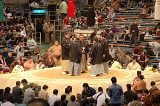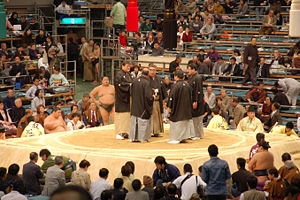
Shimpan
Encyclopedia

Sumo
is a competitive full-contact sport where a wrestler attempts to force another wrestler out of a circular ring or to touch the ground with anything other than the soles of the feet. The sport originated in Japan, the only country where it is practiced professionally...
bout. In a sumo honbasho
Honbasho
A is an official professional sumo tournament. There are six held each year, a system established in 1958. Only honbasho results matter in determining promotion and relegation for rikishi ....
tournament five shimpan sit around the ring to observe which wrestler wins the matchup. When judging tournament bouts they wear formal Japanese dress of otokomono, haori with mon
Mon (badge)
, also , , and , are Japanese emblems used to decorate and identify an individual or family. While mon is an encompassing term that may refer to any such device, kamon and mondokoro refer specifically to emblems used to identify a family....
, and hakama
Hakama
are a type of traditional Japanese clothing. They were originally worn only by men, but today they are worn by both sexes. Hakama are tied at the waist and fall approximately to the ankles. Hakama are worn over a kimono ....
. At the end of each bout an initial decision is given by the gyoji
Gyoji
A Gyōji is a referee in professional sumo wrestling in Japan.Gyōji usually enter the sumo world as teenagers and remain employees of the Sumo Association until they retire aged 65.-Responsibilities:...
, which is usually correct and no action is taken by the shimpan.
If one of the shimpan disagrees or is unsure about the decision then he raises his hand and the five of them climb into the ring, or dohyo
Dohyo
thumb|A dohyōThe dohyō is the ring in which sumo wrestling bouts are held. A modern dohyo is a circle of rice-straw bales 4.55 meters in diameter, mounted on a square platform of clay 6.7m on a side, and 34 to 60 cm high. The surface is covered by sand.A new dohyō is built prior to each...
to hold a mono-ii. A mono-ii (of the shimpan only) can in principle also be called by any of the four sumo wrestlers awaiting their bout around the ring, although it is an extremely rare occurrence.
During the mono-ii the five shimpan give their views on what happened. The gyoji is usually able to listen in but is not expected to take part unless invited to do so. For top division matches, the deliberations are further advised by two further shimpan in a video room, in communication with the chief shimpan (who is always one of the three senior members of the judging committee) via an audio link in his ear.
The use of video was brought in at a result of a famous bout in March 1969 in which the yokozuna Taihō
Taiho Koki
Taihō Kōki is the 48th Yokozuna in the Japanese sport of sumo wrestling. He is generally regarded as the greatest sumo wrestler of the post-war period. He became a yokozuna in 1961 at the age of 21, the youngest ever at the time, and he won a record 32 tournaments between 1960 and 1971...
was adjudged to have lost the bout despite subsequent replays and photographs indicating otherwise. The referee had originally the match to Taihō, but the judges reversed his decision. The loss of this bout broke an extremely unusual 45 bout winning streak by the yokozuna and consequently the decision received much adverse publicity. One of the two shimpan in the video booth must now also be one the three most senior judges. This rule was brought in as a result of judging controversies in the 1990s.
The result of the mono-ii can be to uphold the gyoji's decision (so-called gunbai
Gunbai
thumb|right|A sumo gyoji wielding a gunbaiThe is a type of Japanese war fan.-Description:Gunbai were used by samurai officers in Japan to communicate commands to their troops, and were solid, not folding, and usually made of wood, wood covered with metal, or solid metal.It is also a key accessory...
-dori), reverse his decision (gunbai-sashichigai), or call a rematch (torinaoshi). The chief shimpan is responsible for making the announcement and a brief explanation to the wrestlers and spectators.
All the shimpan are oyakata, or members, of the Japan Sumo Association
Japan Sumo Association
The is the body that operates and controls professional sumo wrestling in Japan under the jurisdiction of the Japanese Ministry of Education, Culture, Sports, Science and Technology. Rikishi , gyōji , tokoyama , and yobidashi , are all on the Association's payroll, but the organisation is run...
and are members of its judging committee. At the end of each honbasho tournament the judging committee members also have the responsibility to decide the ranking of the wrestlers for the following tournament, which includes making the initial formal recommendation for the promotion of a wrestler to the rank of ozeki to the Sumo Association board of directors. (A special advisory body of external members is responsible for initial recommendations of promotion to the top rank of yokozuna.)
The judging committee has 23 members at any one time, including the three chief shimpan who serve two year terms. The other 20 members serve one year terms. An oyakata must normally wait at least five years after retirement to become a shimpan, and is normally expected to have reached at least a high maegashira rank as an active wrestler. The chief shimpan are nearly always former yokozuna or ozeki.

